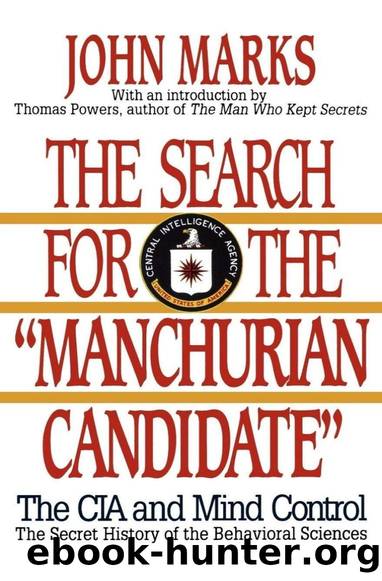The Search for the Manchurian Candidate: The CIA and Mind Control by John Marks

Author:John Marks [Marks, John]
Language: eng
Format: epub
ISBN: 9780393307948
Amazon: 0393307948
Barnesnoble: 0393307948
Goodreads: 342573
Published: 2004-04-09T19:17:17+00:00
97
returned to his lab at Parke, Davis after a year of postdoctoral research at the University of Basel. His supervisor had called him in with an intriguing proposal: How would he like to work inside the company on a CIA contract? âThose were not particularly prosperous times, and the company was glad to get someone else to pay my salary [$8,000 a year],â notes Moore 25 years later. âIf I had thought I was participating in a scheme run by a small band of mad individuals, I would have demurred.â
He accepted the job.
The Agency contracted with Parke, Davis, as it did with numerous other drug companies, universities, and government agencies to develop behavioral products and poisons from botanicals. CIA-funded chemists extracted deadly substances like the arrow-poison curare from natural products, while others worked on ways to deliver these poisons most effectively, like the ânondiscernible microbioinoculatorâ (or dart gun) that the Army Chemical Corps invented. CIA-connected botanists collectedâand then chemists analyzedâbotanicals from all over the tropics: a leaf that killed cattle, several plants deadly to fish, another leaf that caused hair to fall out, sap that caused temporary blindness, and a host of other natural products that could alter moods, dull or stimulate nerves, or generally disorient people. Among the plants Moore investigated was Jamaica dogwood, a plant used by Caribbean natives to stun fish so they could be easily captured for food. This work resulted in the isolation of several new substances, one of which Moore named âlisetin,â in honor of his daughter.
Moore had no trouble adjusting to the secrecy demanded by his CIA sponsors, having worked on the Manhattan Project as a graduate student. He dealt only with his own case officer, Henry Bortner, and two or three other CIA men in TSS. Once Moore completed his chemical work on a particular substance, he turned the results over to Bortner and apparently never learned of the follow-up. Moore worked in his own little isolated compartment, and he soon recognized that the Agency preferred contractors who did not ask questions about what was going on in the next box.
In 1955 Moore left private industry for academia, moving from Detroit to the relatively placid setting of the University of Delaware in Newark. The school made him an assistant professor, and he moved into a lab in the Georgian red-brick building that housed the chemistry department. Along with his family, Moore brought his CIA contractâthen worth $16,000 a year, of which he received $650 per month, with the rest going to pay research assistants and overhead. Although the Agency allowed a few top university officials to be briefed on his secret connection, Moore appeared to his colleagues and students to be a normal professor who had a healthy research grant from the Geschickter Fund for Medical Research in Washington.
In the world of natural productsâparticularly mushroomsâthe CIA soon made Moore a full-service agent.
With some help from his CIA friends, he made contact with
Download
This site does not store any files on its server. We only index and link to content provided by other sites. Please contact the content providers to delete copyright contents if any and email us, we'll remove relevant links or contents immediately.
| Espionage | Hoaxes & Deceptions |
| Murder & Mayhem | Organized Crime |
| Serial Killers | White Collar Crime |
Mindhunter: Inside the FBI's Elite Serial Crime Unit by John E. Douglas & Mark Olshaker(9206)
Wiseguy by Nicholas Pileggi(5674)
Room 212 by Kate Stewart(5040)
Hitman by Howie Carr(5022)
Secrecy World by Jake Bernstein(4651)
Killers of the Flower Moon: The Osage Murders and the Birth of the FBI by David Grann(4387)
Papillon (English) by Henri Charrière(4199)
Breaking Free by Rachel Jeffs(4175)
Killers of the Flower Moon by David Grann(3971)
Say Nothing by Patrick Radden Keefe(3903)
American Kingpin by Nick Bilton(3759)
The Secret Barrister by The Secret Barrister(3615)
Molly's Game: From Hollywood's Elite to Wall Street's Billionaire Boys Club, My High-Stakes Adventure in the World of Underground Poker by Molly Bloom(3486)
Mysteries by Colin Wilson(3397)
In Cold Blood by Truman Capote(3311)
Signature in the Cell: DNA and the Evidence for Intelligent Design by Stephen C. Meyer(3075)
I'll Be Gone in the Dark by Michelle McNamara(3024)
Rogue Trader by Leeson Nick(2977)
Bunk by Kevin Young(2950)
